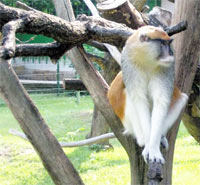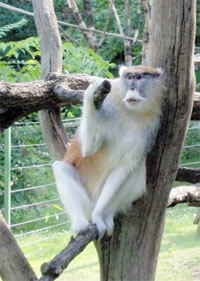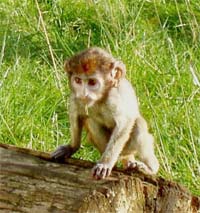|


Body like a greyhound: The Patas Monkey grows to 85 cm in length, excluding the tail, which measures 75 cm. The body of the patas monkey has been compared to a greyhound dog, with a narrow body, a prominent rib cafe andlong legs. This makes sense, because greyhounds are the fastest dogs, and patas monkeys are the fastest land primates. The long legs give it an enormous stride. Their coat is a reddish brown color, with gray whiskers on its chin and a white mustache. The tail is long and helps with balance.

These monkeys are entirely terrestrial, and their behavior has been compared to baboons, another monkey that lives mostly on the ground
Fastest primate on land! Patas monkeys Erythrocebus patas can run on the ground at up to 31 miles (50 kilometers) per hour, making them the fastest primate on land.
 Watch-monkey: Patas monkeys have one dominant, completely adult male per group, which have about 15 members. The male's role of watchdog and guard works with the open country, because the group is easily viewed by predators like leopards and hyenas. The male will stand on two feet to peep out from the tall grass, sometimes using his tail for balance, or climb into a lone tree to search for danger. Watch-monkey: Patas monkeys have one dominant, completely adult male per group, which have about 15 members. The male's role of watchdog and guard works with the open country, because the group is easily viewed by predators like leopards and hyenas. The male will stand on two feet to peep out from the tall grass, sometimes using his tail for balance, or climb into a lone tree to search for danger.
Distracting danger: If he does spot danger, he does not let out a loud alarm noise - instead, he alerts the grou with a very soft "chirruping" call. This alert causes them to stay still, silent and crouched in the grass as hidden as possible, while the male then plays decoy - he will peform an obvious diversionary display. Going in the opposite direction of the group of females and young (which will then escape while he distracts the predator), he will bounce around the branches of the trees loudly.
Changing leading males: Other males (since there is only one adult male per group) will live in separate bands. Sometimes these members will try to come near female troops and send away the single male of that troop, taking his place. This is a frequent occurrence, and biologically desirable as a measure against inbreeding. troops and send away the single male of that troop, taking his place. This is a frequent occurrence, and biologically desirable as a measure against inbreeding.
Speed monkeys: The patas monkeys are able to climb small trees when in danger, but usually choose to escape by foot on the ground because of their remarkable speed. They are always on high alert and rarely allow anything to approach them. Young monkeys will get away when chased by going up a small tree.
Ground grub: Patas monkeys are omnivores, but are able to live as herbivores or carnivores. They gather insects from the ground, in addition for buds, grubs, leaves, roots, and fruits.

There are two subspecies: the western Erythrocebus patas patas (Common Patas) and the eastern Erythrocebus patas pyrrhonotus (Nisnas). The Nisnas has a white nose, while the nose of the Common Patas Monkey is black.
Baboon | Howler Monkey | Lion Tamarin | Mandrill | Marmoset | Squirrel Monkey
Primates| Apes| Monkeys| Prosimians
All text is available under the terms
of the GNU Free Documentation License
|